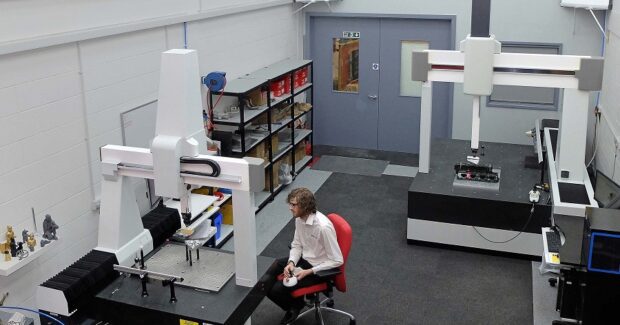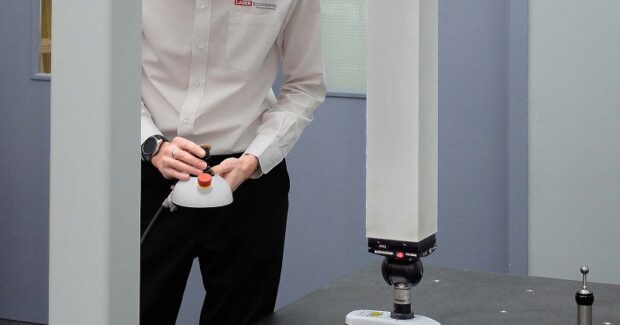Under Contract: Automated CMM Operations
A manual inspection process using an arm is almost impossible to replicate, so shops hire Laser Scanning to run automated CMM programs for them that are highly repeatable.
Posted: October 31, 2019
Following the installation of an LK 20.12.10 ceramic-bridge coordinate measuring machine with a 2,000 mm x 1,200 mm x 1,000 mm working volume from LK Metrology Ltd (Castle Donington, UK), contract inspection and reverse engineering capacity at Laser Scanning Ltd (Sheffield, UK) doubled in terms of throughput while the size of the part they can measure increased more than five-fold. This larger CMM joins a smaller LK 8.7.6 CMM that managing director Johnathan Rigby brought with him from his previous employer, PMS Diecasting Ltd – a firm that now subcontracts much of their metrology requirements to Laser Scanning. Both companies are members of the Glide Group, along with plastic injection molding specialist Loadhog, toolmaker GoTools, and wire joining and tensioning product manufacturer Gripple. Laser Scanning is accredited to ISO 9001 for quality management, ISO 14001 for environmental management, ISO 18001 for occupational safety and health, and ISO 27001 for data security. They are a member of GTMA (Gauge & Toolmakers Association), Federation of Small Businesses and Employee Ownership Association.
Most data acquisition at Laser Scanning is performed on these two LK CMMs and two articulated arms supplied by Nikon Metrology. All of this equipment is housed in a temperature-controlled room held at 20 ± 1 deg C in their Chapeltown facility near Sheffield. Parts delivered for inspection are acclimatized in the same room for 24 hours to reduce measurement uncertainty. Three types of Nikon non-contact sensors are used on the CMMs: an XC65D cross scanner and line scanner models L100 and LC15Dx, which respectively have 13.0 µm, 6.5 µm and 1.8 µm measuring accuracy. The LC15Dx provides performance that is equivalent to tactile probing that is also utilized by Rigby and his team for capturing physical dimensions, such as hole diameters, using a TP20 touch probe and SP20 scanning probe from Renishaw. A changing rack mounted on the CMM table allows automatic sensor exchange within an inspection cycle.
The purchase of the larger CMM was prompted by Rigby’s receipt of a contract from JCB Power Systems (Derby, UK) to assist with quality control of cylinder blocks and heads for the engines that power the OEM’s off-road vehicles. While JCB has its own LK machine equipped with a touch probe that serves their production line, Laser Scanning provides measurement and inspection of goods received into the plant, where a QC engineer is permanently stationed. They also help with preparing CMM programs and proving them out, as well as inspecting prototypes to support JCB’s research and development department. This is particularly important because Laser Scanning can furnish much more comprehensive and accurate information about a new component than is possible using the touch probing techniques at JCB. Although the engine plant does have laser scanning capability on an articulated arm with a scanning resolution of 23 µm, the level of detail they can acquire is much lower than the best CMM-mounted scanner used by Laser Scanning.
In any case, inspection using an arm would be a manual process and almost impossible to replicate on subsequent occasions, whereas running a program on a CMM is automated and highly repeatable. “By working with their inspection department and R&D team, we have been able to free up their machine to concentrate on production QC,” explained Rigby. “They also appreciate the greater detail we can provide about new prototypes: laser scanning allows us to show them the form of a part as well as supply measurement data. For example, they recently asked us to help them with a new rocker cover housing that had been plastic injection molded to determine whether the gasket area was within tolerance after shrinkage in the manufacturing process. Inspecting a planar surface such as the gasket area by touch probing at multiple points would not give an overall idea of its flatness and, in all probability, if the exercise were repeated the results would be different. In contrast, scanning generates millions of points that provide a detailed 3D picture of the entire surface at a very high level of precision, and the deviations can be quantified. It enables JCB to show their mold tool supplier exactly where any inaccuracies are.”
Laser Scanning is ideally located to help any manufacturer that uses LK measuring machines and software, since work and programs can be transferred seamlessly to run on either CMM. Recent projects have involved a Tier 2 supplier in the Midlands to the global aerospace industry that used Laser Scanning subcontract services for inspecting parts while their own machine was out of action, and a medical equipment manufacturer that wanted to verify their in-house QC capability. About half of Laser Scanning’s turnover is derived from reverse-engineering legacy parts for which models and drawings do not exist. Machine shops and toolmakers are frequent customers. The inspection provider also delivers a service to designers: The version 8.5 LK CAMIO software used at their Chapeltown facility features interoperability across CMM platforms and sensor technologies that create efficient inspection programs for measuring geometrical features and evaluating surfaces using advanced point cloud analysis, with part-to-CAD comparison and full reporting capability.
“CAMIO has a Microsoft Office feel to it, with a similar customizable icon ribbon at the top of the screen,” stated Rigby. “It is very user-friendly, with programming functions that are easily accessible and not buried inside drop-down menus. Version 8.5 interfaces with our Geomagic software from 3D Systems so that we can create accurate models from 3D scan data, as well as use it for QC and measurement. We regard our association with LK and Nikon as two-way partnerships: They provide us with all the support we need, and we feed back information to the OEMs to assist in their development of the next generations of systems.”
Laser Scanning Ltd, Unit 18, Chambers Way, Thorncliffe Park Estate, Newton Chambers Road, Sheffield, UK S35 2PH, +44 (0) 114 257 3650, [email protected], www.laser-scanning.co.uk.
LK Metrology, Inc., 12701 Grand River, Brighton, MI 48116, 810-263-6100, [email protected], www.lkmetrology.com.
















